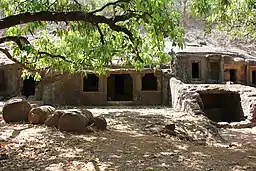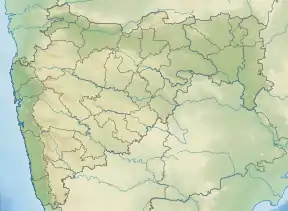Panhalakaji Caves
Panhalakaji Caves are situated in the Ratnagiri district of Maharashtra state, about 160km south of Mumbai. This cave complex has around 30 Buddhist Caves.[1] The Hinayana sect began carving caves in 3rd century AD, beginning with the stupa in the current Cave 5.[2] The caves have inscriptions in Brahmi and Devanagari script.[1] In the 10-11th century AD another Buddhist group, a Vajrayana sect, established cave 10 with their deities Akshobhya and Mahachandaroshana; and strengthened their practice in that region. Shiva and Ganpatya worshiping started at the site during Silahara rule.[2] There are total 29 caves out of which 28 are situated on the right bank of mou tain stream Kotjai.
| Panhalakaji Caves | |
|---|---|
 Panhalakaji Caves | |
  | |
| Coordinates | 17.645678°N 73.245072°E |
| Pilgrimage to |
| Buddha's Holy Sites |
|---|
 |
| The Four Main Sites |
| Four Additional Sites |
| Other Sites |
|
| Later Sites |
A list of important caves includes:[2]
- Cave 10 has and image of Maha-Chandraroshana. This deity is shown on the stupa which signifies the connection of Ratnagiri with ancient Buddhist sites of Orissa.
- Cave 14 has deities of Nath Pantha.
- Cave 19 has shivlinga in it. It has Hindu scriptures on its ceiling.
- Cave 29 was used by Nath Pantha and was renamed as Gaur Lena.
 Pillars
Pillars Frieze with elephants.
Frieze with elephants. Stone pillar .
Stone pillar . stone carving.
stone carving. Stone carving.
Stone carving.
How to reach
- By train: Nearest Rail station is Khed, Ratnagiri.[1]
- By road: Located on NH 4 highway near Dapoli.[1]
Further reading
Deshpande, Madhusudan Narhar (1986). The caves of Panhāle-Kājī (ancient Pranālaka): an art historical study of transition from Hinayana, Tantric Vajrayana to Nath Sampradāya (third to fourteenth century A.D.). New Delhi: Archaeological Survey of India. ASIN B0006EPMPS. OCLC 923371295. Retrieved 5 February 2021.
References
- ET Bureau (18 April 2013). "Quick getaway: Dapoli, Saharanpur, Nanjagud". Economic Times. Bennett, Coleman & Co. Ltd. Retrieved 10 November 2013.
- Mitra, Debala (1984). India Archaeology 1981-82 (PDF). New Delhi: Archaeological Survey of India, Government of India. pp. 97, 98. Archived from the original (PDF) on 26 November 2013. Retrieved 10 November 2013.
